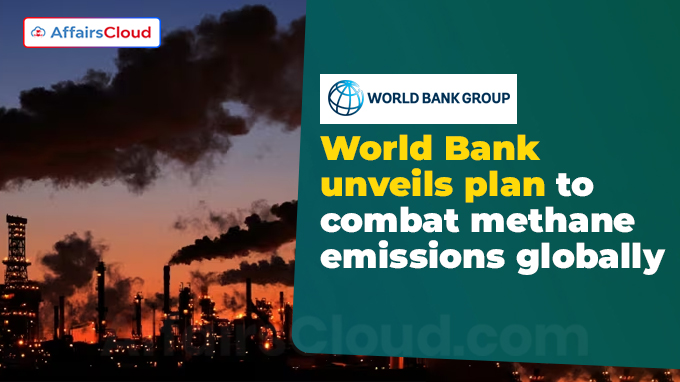 The World Bank (WB) launched partnership platforms namely the Global Methane Reduction Platform for Development (CH4D), a hub for methane reduction in agriculture and waste, and the Global Flaring and Methane Reduction Partnership (GFMR) which focuses on reducing methane leaks in the oil and gas sector.
The World Bank (WB) launched partnership platforms namely the Global Methane Reduction Platform for Development (CH4D), a hub for methane reduction in agriculture and waste, and the Global Flaring and Methane Reduction Partnership (GFMR) which focuses on reducing methane leaks in the oil and gas sector.
- WB also launched an 18-month “blueprint for methane reduction” to set up 15 national programs to reduce methane emissions.
- The proposals were launched at the 28th Conference of the Parties (COP28) of the United Nations Framework Convention on Climate Change (UNFCCC), being held in Dubai, United Arab Emirates (UAE) from 30 November to 12 December 2023.
Note:
- WB framed these initiatives as part of its efforts with countries like Germany, Norway, and the United States of America (USA), as well as the private sector.
- Methane (CH4) is 80 times more dangerous than Carbon dioxide (CO2) in contributing to global warming.
Global Methane Reduction Platform for Development (CH4D):
i.CH4D aims to help low- and middle-income countries realize the ‘methane triple-wins’ of reducing methane emissions, improving resilience, and strengthening livelihoods.
ii.Collaborations with entities like the Climate and Clean Air Coalition (CCAC) Methane Roadmap Action Programme (M-RAP), CH4D will mobilise expertise, affordable technologies, and catalytic finance for methane reduction in the agriculture and waste sectors.
Global Flaring and Methane Reduction Partnership (GFMR):
i.WB launched its GFMR with USD 255 million in new grant funding to catalyse oil and gas methane and flaring reduction in developing countries.
- GFMR is financially supported by a coalition including the UAE, USA, Norway, BP, ENI, Equinor, Occidental, Shell, and TotalEnergies.
ii.The GFMR’s mission is to boost global efforts to end routine gas flaring and reduce methane emissions to the greatest extent possible along the entire oil and gas value chain by:
- Providing technical assistance;
- Enabling policy and regulatory reform;
- Strengthening institutions; and
- Mobilising finance to support action by governments and Oil and Gas operators.
iii.The GFMR will strategically target, fund, and sustain engagements with countries representing the greatest emissions reduction potential.
Note: Despite its significant impact, funding for methane reduction is less than 2% of global climate finance.
Commitment Criteria:
i.Access to GFMR support is contingent on commitments such as achieving near-zero methane emissions by 2030 by reducing methane intensity to below 0.2% and achieving zero routine flaring by 2030.
ii.Also to measure and report methane emissions through the Oil and Gas Methane Partnership 2.0 framework, and endorse the Global Methane Pledge (GMP).
- GMP is a voluntary effort to reduce global methane emissions by at least 30% from 2020 levels by 2030.
Blueprint to cut Methane Emissions:
WB announced its plan to launch 15 national programs in the next 18 months aimed at reducing methane emissions. These programs will reduce up to 10 million tons of methane.
Key Points:
i.Methane represents around 19% of the global greenhouse gas (GHG) emissions. Rice production accounts for 8%, livestock 32%, and waste 18% of all human-driven methane emissions.
ii.The programs will deploy the best available technologies through which methane emissions from rice production can be reduced by up to 40%, for livestock by up to 30%, and for waste by up to 80%.
iii.WB commits to support the interventions where methane emissions are projected to rise significantly, aiding policy-making through analytics, and unlocking financing from 2024 to 2030.
Recent related News:
The International Energy Agency (IEA) released its ‘Gas 2023 Medium-Term Market Report’. As per it, India’s natural gas demand is expected to rise by 4% in the 2023 calendar year and will continue to increase at an average annual rate of about 8% till 2026.
About World Bank (WB):
World Bank Group President– Ajay Banga
Headquarters– Washington, DC, USA
Established in– 1944




